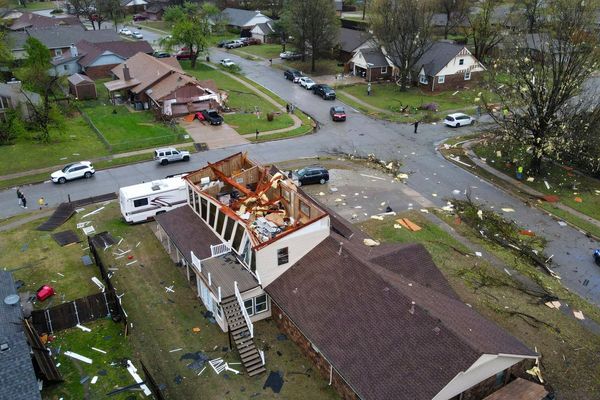Michelle McKeough was looking into the social history of Fremantle for her PhD research when she stumbled across a document about the outbreak of bubonic plague in the port city in the early 1900s, and was intrigued.
"I followed it up and found this treasure trove of information about years of bubonic plague that we went through, that hadn't been written about," Dr McKeough told Christine Layton on ABC Radio Perth.
"It was just the most exciting find."
Striking similarities to COVID-19 pandemic
In council offices and the WA state records office she found boxes of correspondence and data showing the number of people diagnosed with plague, lists of people put into isolation and records of people protesting about their conditions in quarantine.
"There are a lot of parallels [with COVID-19]," she said.
When a worldwide bubonic plague outbreak was first detected in 1898, there was an "international convention to decide on how best to deal with it".
"They came up with agreements, such as: 'Everybody know how many patients there were, if you had a plague patient in your city on your shores.'"
Tracking down rats
The bubonic plague, which swept through Europe in the 1300s and killed one-third of the population, is commonly spread by flea-bitten rats that go on to infect humans.
"Fremantle was a working port, obviously there was a lot of trade coming in from overseas and from other places in Australia," Dr McKeough said.
"There are usually rats in a working port, and there are rats in places where the sanitation is less than it should be.
"When the international pandemic was travelling across the British maritime trading world, Fremantle was going to be an obvious site where it could potentially come in and that's what happened."
Unlike COVID-19 however, the bubonic plague remained localised in small areas of Perth and Fremantle.
"In Perth, there was only one area where the plague came, it was a big plague hotspot, and it was the area bounded by Wellington Street, Hay Street, Pier Street and William Street," Dr McKeough said.
"Every [Perth] plague victim from 1900 to 1906 came out of there.
"In Fremantle, it was the West End and the same environment, with lots of overcrowding.
"We'd had the gold rush, and they just hobbled together in ramshackle tenements and people were living in terrible conditions, there wasn't proper sewerage, there wasn't fresh water."
Swift response required
Dr McKeough said while there were treatments and inoculations for the plague available, public health authorities had to act quickly.
"The very first Perth plague victim went to work on Thursday and complained he was feeling ill," she said.
"By Sunday, he was dead of the bubonic plague.
"If they didn't pick up that you had plague quickly, you would die within a few days and it was a painful death.
"If they found that you had plague early enough, they could cure you with an inoculation."
In total, 80 people were infected with bubonic plague in WA, in various outbreaks between 1900 and 1906, and 35 died.
"The reason that's got the name bubonic is because you'd get these things called buboes -- swellings under the skin -- and they would burst through very painfully.
"By the time you had those, it was almost too late. The high fevers would bring on delusions and hallucinations.
"Often heart failure was the thing that ultimately killed a lot of the plague patients. It was a nasty way to die."
Contacts sent to quarantine
Dr McKeough said as cases were reported, authorities would race to identify close contacts to offer them inoculations and force them into quarantine at Woodman Point, south of Perth.
Public health officers and teams of workers were deployed to kill all the rats in an area and thoroughly disinfect the streets and buildings to stop the spread.
But these measures also caused consternation, especially the mandatory quarantine.
"If you had plague in your house, everyone would be taken down to Woodman Point and monitored, and then your house would be inspected," Dr McKeough said.
"You'd probably have had to make some changes to your house which were pretty costly.
"You couldn't earn an income while you were [in quarantine], and you weren't compensated for that."
This unwillingness to be drawn into the machinations of disease control led, on at least one occasion, to desperate choices.
"At one point [two years into the outbreak] a guy living and working on King Street in Perth got the plague," she said.
"All the people in the house said: 'Well, he's about to die, let's avoid all this examination and loss of income'.
"He was a Chinese market gardener and they put him in a cart going out to Wanneroo, where the market garden was, and put him under a tree.
"It took the poor man two days to die."
Borders go up
As well as leading to a frantic contact-tracing effort to figure out where the man had come from, Dr McKeough said the incident also led to a sharp rise in anti-Chinese sentiment in Perth.
"Suddenly the Chinese were being blamed for having the plague, even though we'd had already had it for nearly two years, and no-one else had been blamed for it," Dr McKeough said.
"There were all these vitriolic newspaper reports laying the blame squarely at the feet of the Chinese."
Of all the similarities with the coronavirus-pandemic management she noted in her research, the one that stood out the most to Dr McKeough was the use of closed borders.
"During the plague outbreaks they were setting up barriers all the time to say, 'We've got to stop letting it in,'" she said.
"There was an argument from Sydney at one stage where they said, 'We've had a case but it was pretty far out of Sydney, so we want you to break the rules and let us come into WA' and the [WA authorities] said, 'No, you haven't done it for us so we're not doing it for you.'"
Changes to sanitation
Dr McKeough said the response to the periodic outbreaks of plague between 1900 and 1906 ultimately led to widespread improvements in sanitation and public health across the community.
"Most of the conditions that we have now for building a house and our sewerage were a direct result of having bubonic plague for over six years here," she said.
"They concentrated on changing the sewerage system.
"They introduced a better system of getting fresh water into places, and they introduced a building licence system so that if you were building a house, you had to actually get it approved by the council, and do things like tarring instead of dirt, so that your environment would actually stay cleaner."
Damien Hassan, senior archivist at the State Records Office, said Dr McKeough's research in the archives had brought to light a little-known part of the state's history.
"There are so many parts of our state history that we're still uncovering, almost hidden in plain sight," he said.
Mr Hassan said the 200 volumes of documents on bubonic plague painted a vivid picture.
"Looking at the files, you get the sense of this wave of infection approaching Western Australia," he said.
"It starts from the late 1800s, they get these reports in from overseas, and then it hits Australia."







